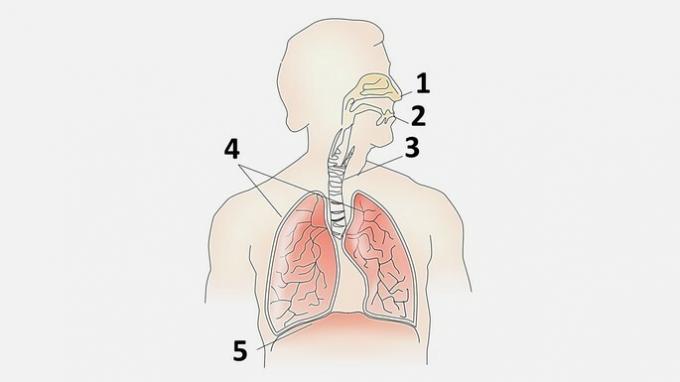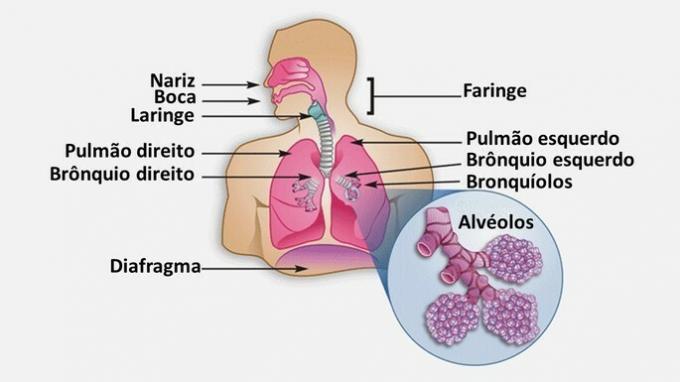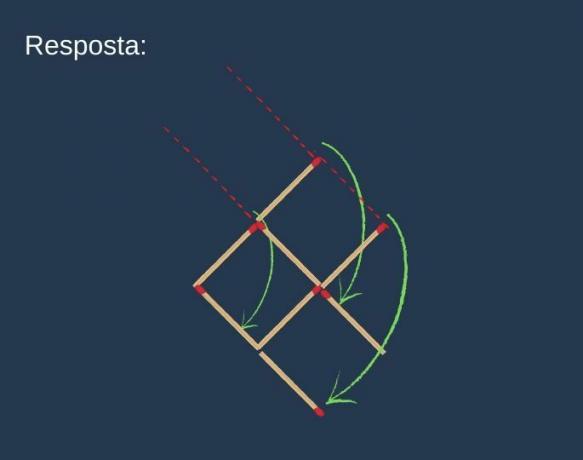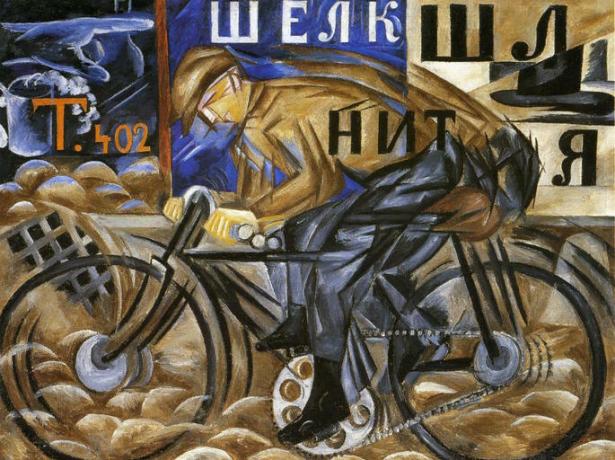The respiratory system is responsible for capturing oxygen (O2) from the air to our body and release carbon dioxide (CO2) after a series of transformations.
question 1
The respiratory system is made up of organs that work to balance the body. Among its functions are: gas exchange, pulmonary defense and sound production. Check the correct alternative that identifies the organs of the respiratory system listed below:

a) 1-nose, 2-mouth, 3-pharynx, 4-lungs and 5-trachea
b) 1-nose, 2-mouth, 3-larynx, 4-lungs and 5-diaphragm
c) 1-nose, 2-mouth, 3-trachea, 4-lungs and 5-diaphragm
d) 1-nose, 2-mouth, 3-alveoli, 4-lungs and 5-trachea
e) 1-nose, 2-mouth, 3-bronchi, 4-lungs and 5-diaphragm
Correct alternative: c) 1-nose, 2-mouth, 3-trachea, 4-lungs and 5-diaphragm.

O nose is responsible for the entry of air into the body, carrying oxygen (O2) necessary for our survival. Although it is also possible to breathe through the mouth, it is ideal to do so through the nose, as the nasal cavities contain hairs that filter and regulate the temperature of the air before entering the respiratory system.
THE mouth performs both the output of carbon dioxide (CO2,) produced by cells after oxygen absorption, regarding food intake.
THE trachea it heats, humidifies and filters the air before it is transported to the bronchi.
US lungs breathing causes oxygen to be converted to carbon dioxide.
O diaphragm it is the muscle that causes the inhale and exhale movements to occur.
Learn more about Respiratory system
question 2
The human being has two lungs, the right and the left, which are spongy organs located inside the rib cage. Each lung has about 200 million very small structures that fill with air.

Look at the drawing and identify what the name of these highlighted structures is and how they act on the respiratory system.
Correct answer: Alveoli, responsible for exchanging oxygen into carbon dioxide.

The alveoli are sac-like structures located at the ends of the bronchioles. They make the lungs look spongy.
The alveoli are lined with blood capillaries and, in this way, the inhaled air, which contains oxygen, is in contact with the blood, carrying out gas exchange.
Learn more about Pulmonary Alveoli
question 3
(FEBA) Hematosis occurs:
a) in the cytoplasmic matrix
b) in the mitochondrial matrix
c) in the cardiac atria
d) in cardiac ventricles
e) in the pulmonary alveoli
Correct alternative: e) in the pulmonary alveoli.
a) WRONG. Also called hyaloplasm or cytosol, some of its functions are: to regulate intracellular pH, store substances and contribute to cell movement.
b) WRONG. It is the central space of the mitochondria, a region that houses organelles such as ribosomes, responsible for the production of proteins.
c) WRONG. They are upper blood-collecting cavities, which facilitate its circulation and direction to the heart.
d) WRONG. They are lower blood-collecting cavities, responsible for the exit of blood from the heart.
e) CORRECT. In hematosis, oxygen is diffused into the blood in capillaries. Likewise, by diffusion, cells release carbon dioxide into the alveoli.
Learn more abouthematosis
question 4
Inhaling and exhaling are breathing movements performed, respectively, for the entry and exit of air from our body. Inspiration is caused by the contraction of which muscle in the respiratory system?
a) Lung
b) Diaphragm
c) Epiglottis
d) Pharynx
e) Larynx
Correct alternative: b) Diaphragm.
a) WRONG. It is responsible for gas exchange, where blood is oxygenated and carbon dioxide is eliminated.
b) CORRECT. Breathing is controlled in the spinal cord by a nerve center. In this place, a nervous impulse is generated that stimulates the contraction of the thoracic muscles, the region where the diaphragm is located, causing us to inhale.
To bring in air during inspiration, the diaphragm contracts, which descends and increases the rib cage. Air enters the lungs when the internal pressure in the rib cage decreases and becomes less than atmospheric air pressure.
In order to release air during expiration, the diaphragm relaxes, the rib cage has decreased in volume and the intrapulmonary pressure increases.
c) WRONG. Its function is to prevent the passage of food to the airways, closing during swallowing.
d) WRONG. It communicates between the nose and mouth, connecting them to the larynx and esophagus.
e) WRONG. Responsible for phonation and breathing, receives air from the pharynx, and prevents food from passing into the trachea.
Learn more about Diaphragm
question 5
(UnB) Mark the alternative that presents a common structure to the respiratory and digestive system.
a) Bronchi
b) Pharynx
c) Lung
d) Esophagus
e) Larynx
Correct alternative: b) Pharynx.
a) WRONG. It is a structure that makes up the respiratory system, which directs air to the lungs.
b) CORRECT. The pharynx connects the digestive and respiratory systems. It is a membranous channel connected to the nose, where it receives air, and to the mouth, to obtain food.
This organ allows the passage of air and food due to the connection with the larynx and esophagus. However, existing blockages mean that air and food never meet.
c) WRONG. It is a structure that makes up the respiratory system, whose function is to carry out the gas exchange between oxygen and carbon dioxide.
d) WRONG. It is a structure that makes up the digestive system, whose function is to carry food to the stomach.
e) WRONG. It is a structure that makes up the respiratory system, is responsible for phonation and also prevents food from entering the system.
Learn more aboutPharynx
question 6
In pulmonary breathing, oxygen travels through the body until it reaches the lungs, where gas exchange takes place. Identify the correct path that air takes through the human body's respiratory system.
a) Nasal cavities, pharynx, larynx, trachea, bronchi, bronchioles and pulmonary alveoli
b) Nasal cavities, larynx, trachea, pharynx, bronchi, bronchioles and pulmonary alveoli
c) Nasal cavities, larynx, bronchi, bronchioles, pharynx, trachea and pulmonary alveoli
d) Nasal cavities, pharynx, larynx, bronchi, bronchioles, trachea and pulmonary alveoli
e) Nasal cavities, pharynx, larynx, bronchi, bronchioles, trachea and pulmonary alveoli
Correct alternative: a) Nasal fossae, pharynx, larynx, trachea, bronchi, bronchioles and pulmonary alveoli.
In the nose, the air is captured and the nasal cavities they filter the air that enters the body to reach the lungs cleaner.
THE pharynx it is connected to the nose and mouth and, therefore, is part of the respiratory and digestive system, allowing the passage of air and food.
THE larynx it is responsible for phonation and prevents food from reaching the lungs due to the existence of an orifice controlled by the epiglottis.
THE trachea it is formed by cartilaginous rings that connect the larynx to the bronchi and is responsible for filtering, heating and humidifying the air in the respiratory system of mammals.
You bronchi direct air to the lungs. At its ends are the bronchioles, branched tubes that carry the air to the pulmonary alveoli, where gas exchange takes place between air and blood.
Learn more about Larynx
question 7
(Fuvest-SP) In men, control of respiratory movements is exercised
a) by the brain
b) by the cerebellum
c) by the bulb
d) by the marrow
d) by the pituitary
Correct alternative: c) by the bulb.
a) WRONG. It is responsible for receiving information, commanding motor actions and neurological activities.
b) WRONG. It is responsible for posture, muscle tone and body movement.
c) CORRECT. In the medulla are located the vital centers that act to control breathing and heartbeat. In it, the respiratory neurons that control the movements of inspiration and breathing are located.
d) WRONG. It is responsible for the nervous system's communication with the body.
e) WRONG. It is a gland responsible for the production of hormones.
Learn more aboutLung Breathing
question 8
External agents, such as fungi, dust and pollen, can cause diseases in the respiratory system. Respiratory diseases are classified as infectious, when inflammation of an organ occurs, or allergic due to sensitivity to an organism. Identify which disease does not occur in the lungs.
a) Tuberculosis
b) Pneumonia
c) Bronchitis
d) Cystitis
e) Asthma
Correct alternative: d) Cystitis.
a) CORRECT. THE tuberculosis is a disease caused by an infection mainly in the lung due to the bacteria called Bacillus of Koch (BK).
b) CORRECT. THE pneumonia is a disease caused by microorganisms (bacteria, viruses, parasites, fungi) and cause infections in the lungs.
c) CORRECT. THE bronchitis is a type of infection caused mainly by viruses that attack the bronchioles in the lungs.
d) WRONG. THE cystitis it happens because of an inflammation or irritation in the bladder, compromising its functioning.
e) CORRECT. THE asthma it is a disease that affects the bronchi in the lungs and causes breathing difficulties.
question 9
(PUC-RJ) Examine the statements below regarding human breathing:
I. It is responsible for the absorption of oxygen (O2) and release of carbon dioxide (CO2).
II. The human fetus breathes through gills while in the amniotic sac, and from the eighth month onwards, the gills transform into lungs.
III. Blood uses white blood cells to transport oxygen, as these greatly increase the blood's ability to transport gases.
IV. The air enters through the nose and passes through the pharynx, larynx, trachea, bronchi, bronchioles and alveoli, where the exchange of gases takes place.
Only the statements are correct:
a) I and II
b) II and III
c) I and IV
d) I, III and IV
e) II, III and IV
Correct alternative: c) I and IV.
I. CORRECT The air we breathe contains oxygen, which is essential for carrying out cellular activities. Within our body, gas exchange takes place and excess carbon dioxide is released to regulate the pH of our body.
II. WRONG. The fetus receives oxygen through the placenta and through the umbilical cord gas exchange is performed and the filtering the oxygen present in the mother's blood, as well as returning carbon dioxide to the bloodstream maternal.
III. WRONG. The transport of oxygen is carried out by red blood cells, which are the red blood cells present in the blood. White blood cells or leukocytes act on the immune system, defending our body from foreign agents.
IV. CORRECT When air enters through the nose, it passes through the pharynx and is directed to the larynx, preventing it from going to the digestive system. In the trachea the air is heated, filtered and humidified and the tubular branches, also called bronchioles, direct the air to the pulmonary alveoli, which form the lungs, where exchanges occur. gaseous.
Learn more about Trachea
question 10
(Mackenzie) The control of human respiratory rate is done by ____________ based on the rate of ____________ blood, which is transported mainly in the form of ____________.
Check the alternative that correctly and respectively fills the spaces of the previous sentence.
a) brain; O2; oxyhemoglobin
b) cerebellum; CO2; carbohemoglobin
c) bulb; CO2; bicarbonate
d) cerebellum; O2; oxyhemoglobin
e) brain; CO2; bicarbonate
Correct alternative: c) bulb; CO2; bicarbonate.
The control of human respiratory rate is done by bulb based on the rate of CO2 blood, which is transported mainly in the form of bicarbonate.
In the medulla are located the centers that control breathing through neurons. This control is done according to the levels of carbon dioxide (CO2) in the blood that allow control of the respiration rate, as respiration is the main means of regulating the pH in the blood.
Increased CO concentration2 lowers the pH, making it more acidic by releasing H+ ions and transporting carbon dioxide in the form of bicarbonate ().
Learn more about the organs of the respiratory system:
- Lung
- bronchi
- bronchioles
- Esophagus


